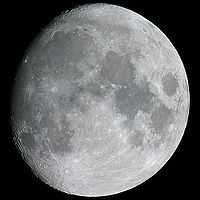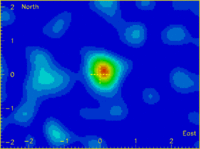Moon
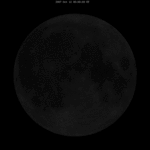
Moon, or the Moon, is Earth's only natural satellite. It is the brightest object in the night sky but gives off no light of its own. Instead, it reflects light from the Sun. Like Earth and the rest of the solar system, the Moon is about 4.6 milliard years old.
The Moon is much smaller than Earth. The Moon's average radius (distance from its centre to its surface) is 1,737.4 km), about 27% of the radius of Earth. The Moon is also much less massive than Earth. The Moon has a mass (amount of matter) of 7.35 x 1019 tonnes. Earth is about 81 times that massive. The Moon's density (mass divided by volume) is about 3.34 g/cm3, roughly 60% of Earth's density.
Because the Moon has less mass than Earth, the force due to gravity at the lunar surface is only about 1/6 of that on Earth. Thus, a person standing on the Moon would feel as if his or her weight had decreased by 5/6. And if that person dropped a stone, the stone would fall to the surface much more slowly than the same stone would fall to Earth.
Despite the Moon's relatively weak gravitational force, the Moon is close enough to Earth to produce tides in Earth's waters. The average distance from the centre of Earth to the centre of the Moon is 384,467 km. That distance is growing, but extremely slowly. The Moon is moving away from Earth at a speed of about 3.8 cm per year.
The temperature at the lunar equator ranges from extremely low to extremely high: from about –173°C at night to +127°C in the daytime. In some deep craters near the Moon's poles, the temperature is always near –240°C.
The Moon has no substantial atmosphere, but small amounts of certain gases are present above the lunar surface. People sometimes refer to those gases as the lunar atmosphere. This "atmosphere" can also be called an exosphere, defined as a tenuous (low-density) zone of particles surrounding an airless body. Mercury and some asteroids also have an exosphere.
The Moon has no life of any kind. Compared with Earth, it has changed little over millions of years. On the Moon, the sky is black (even during the day), and the stars are always visible.
The Moon also crosses the sky occasionally sometimes in the daylight other times at night. The Moon doesn't always reflect uniformly during its travels. A shadow often blocks some of the reflection. Which entity is the cause for this, or is it an object, or perhaps a source of shadow?
Earth and Moon
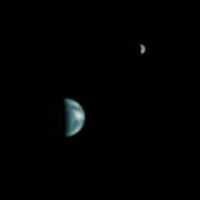
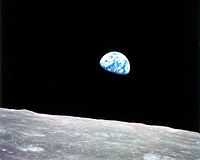
Eclipses and occultations
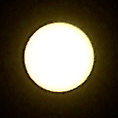
An eclipse is when the light of the Sun or Moon is blocked such as the annular eclipse shown in the image at right on October 3, 2005, observed at Medina del Campo, Valladolid, España.
Observing a solar eclipse tells you that when both objects (the Sun and the Moon) are in the sky at the same time, close to each other, the Moon is between you and the Sun.
On April 25, 1838, an occultation of Mercury by the Moon occurred when Mercury was visible to the unaided eye after sunset.[1] An occultation of Venus by the Moon occurred "on the afternoon of October 14", 1874.[1] An earlier such occultation "occurred on May 23, 1587, and is thus recorded by [Tycho Brahe] in his Historia Celestis"[1].
Explorations
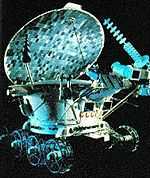
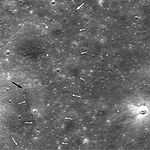
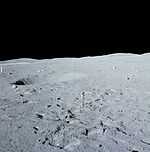
Lunokhod-2 carries on board an X-ray observatory (X-ray telescope), carried to the Moon by Luna 21 to observe solar X-rays. Luna 21 landed on the Moon on January 15, 1973, at 22:35:00 UTC, latitude 25°51' N, longitude 30°27' E. Less than 3 hr later Lunokhod 2 disembarked onto the lunar surface at 01:14 UTC on January 16, 1973. While still near the Luna 21 platform, Lunokhod 2 carried out solar X-ray studies.[2]
At right is a view of the horizon on the Moon's solid surface taken by an Apollo 16 astronaut. The image shows a black sky without stars because the sunlight coming from the left is overwhelming.
Planetary science
The true shape of the Moon is "slightly flattened, with a bulge on one side."[3]
The shape of the Moon is like "a lemon with an equatorial bulge. If you can imagine a water balloon flattening out as you spin it.”[4]
The "moon barely spins, yet it appears to have the sort of equatorial bulge caused by rotation. And why would a giant ball of cooled liquid be anything but spherical?"[3]
“There’s no plate tectonics like on the earth. Why is it so deformed?”[4]
"Its squashed appearance is probably a result of the gravitational process called tidal heating or acceleration, which stretched the moon’s crust as it was being formed. The equatorial bulge probably dates to a later period, when the moon was still spinning but was slowing down and moving away from earth, freezing a tidal surge in place."[3]
“There is an expected ratio you get for each of those two tidal processes. We found the exact ratios you would expect for each process.”[4]
Electromagnetics
"Recent scans of magnetized lunar rocks that show no evidence of effects from cosmic impacts now provide strong evidence that the moon had a magnetic field".[5]
"Earth's magnetic field is currently 50 microteslas in strength. The early moon may have had a magnetic field that was bigger, maybe up to more than 70 microteslas."[6]
Weak forces
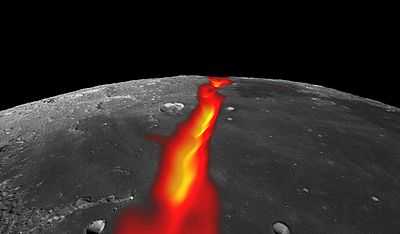
An "analysis of a gravitational map of the 3,200-kilometre-wide ancient volcanic region [Oceanus Procellarum] suggests that it is not a giant impact crater [Features] of the crust beneath the surface [show] that the area is rimmed by structures that run in straight lines and intersect at angles [that] could [...] be the result of geological activity within the Moon's crust."[7]
"Rift zones aren’t something known on the Moon, although we see them on Earth, Venus and Mars.”[8]
Meteors
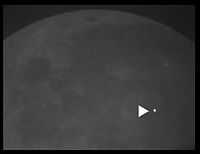
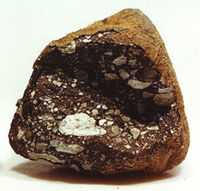
"Lunar origin is established by comparing the mineralogy, the chemical composition, and the isotopic composition between meteorites and samples from the Moon collected by Apollo missions."[9]
"Cosmic ray exposure history established with noble gas measurements have shown that all lunar meteorites were ejected from the Moon in the past 20 million years. Most left the Moon in the past 100,000 years."[9]
"All six of the Apollo missions on which samples were collected landed in the central nearside of the Moon, an area that has subsequently been shown to be geochemically anomalous by the Lunar Prospector mission. In contrast, the numerous lunar meteorites are [likely to be] random samples of the Moon and consequently provide a more representative sampling of the lunar surface than the Apollo samples. Half the lunar meteorites, for example, likely sample material from the farside of the Moon."[9]
At top left is a NASA photograph showing the bright flash of light from a meteor impact that occurred on the Moon on March 17, 2013. According to NASA, a 0.3 m rock slammed into the lunar surface at 90,120 km/h, creating a fresh crater 20 m wide.
"The crash caused the biggest and brightest explosion scientists have seen since they started monitoring lunar meteorite strikes in 2005. ... The lunar blast was the equivalent of 5 tons of TNT going off".[10]
"The flash was so bright it saturated the camera".[11]
Cosmic rays
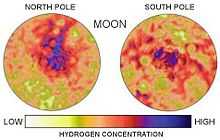
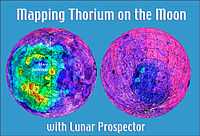
At right is the result of an all Moon survey by the Lunar Prospector using an onboard neutron spectrometer (NS). Cosmic rays impacting the lunar surface generate neutrons which in turn loose much of their energy in collisions with hydrogen atoms trapped within the Moon's surface.[12] Some of these thermal neutrons collide with the helium atoms within the NS to yield an energy signature which is detected and counted.[12] The NS aboard the Lunar Prospector has a surface resolution of 150 km.[12]
Neutrons
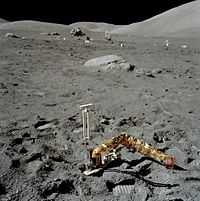

At right is an image showing a neutron detector put into a pre-dug hole on the surface of the Moon by Eugene Cernan of the Apollo 17 lunar surface crew. Also, in the image is a boulder. "Now, this (boulder) ought to shield that thing (the neutron probe) from the doggone (RTG)"[13] "[T]he neutron probe consists of targets containing either boron or uranium-235 which, upon capturing neutrons, emit alpha particles or fission fragments which are then captured by plastic or mica detectors. The instrument consists of an outer tube containing the detectors and a central core containing the targets. Because the targets and detectors do not cover the whole surfaces of the core and tube, respectively, the core can be twisted so that the target/detector pairs are either next to each other or 180 degrees apart. In the latter case, very few alpha particles or fission fragments are captured by the detectors and, therefore, the instrument is "off".[14] "The neutron probe is a self-contained unit and, among other things, has no cable connecting it to electronics on the surface, a cable that would prevent the probe from falling out of reach to the bottom of the core hole. At the end of the third EVA, Jack will return to the ALSEP site and retrieve the probe so that he and Gene can bring it back to Earth for analysis."[14]
At lower right is the result of an all Moon survey by the Lunar Prospector using an onboard neutron spectrometer (NS). Cosmic rays impacting the lunar surface generate neutrons which in turn loose much of their energy in collisions with hydrogen atoms trapped within the Moon's surface.[12] Some of these thermal neutrons collide with the helium atoms within the NS to yield an energy signature which is detected and counted.[12] The NS aboard the Lunar Prospector has a surface resolution of 150 km.[12]
Protons
The Apollo Lunar Surface Experiments Packages (ALSEP) determined that more than 95% of the particles in the solar wind are electrons and protons, in approximately equal numbers.[15][16]
"Because the Solar Wind Spectrometer made continuous measurements, it was possible to measure how the Earth's magnetic field affects arriving solar wind particles. For about two-thirds of each orbit, the Moon is outside of the Earth's magnetic field. At these times, a typical proton density was 10 to 20 per cubic centimeter, with most protons having velocities between 400 and 650 kilometers per second. For about five days of each month, the Moon is inside the Earth's geomagnetic tail, and typically no solar wind particles were detectable. For the remainder of each lunar orbit, the Moon is in a transitional region known as the magnetosheath, where the Earth's magnetic field affects the solar wind but does not completely exclude it. In this region, the particle flux is reduced, with typical proton velocities of 250 to 450 kilometers per second. During the lunar night, the spectrometer was shielded from the solar wind by the Moon and no solar wind particles were measured."[15]
"In February 2009, the ESA SARA LENA instrument aboard India's Chandrayaan-1 detected hydrogen ENAs sputtered from the lunar surface by solar wind protons. Predictions had been that all impacting protons would be absorbed by the lunar regolith but for an as yet unknown reason, 20% of them are bounced back as low energy hydrogen ENAs. It is hypothesized that the absorbed protons may produce water and hydroxyls in interactions with the regolith.[17][18]"[19]
Electrons
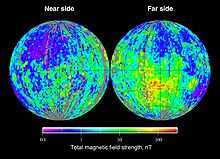
"The electron reflectometer (ER) [aboard the Lunar Prospector determines] the location and strength of magnetic fields from the energy spectrum and direction of electrons. The instrument [measures] the pitch angles of solar wind electrons reflected from the Moon by lunar magnetic fields. Stronger local magnetic fields can reflect electrons with larger pitch angles. Field strengths as small as 0.01 [nanotesla] nT could be measured with a spatial accuracy of about 3 km (1.9 mi) at the lunar surface."[23]
"[T]he shadowed lunar surface charges negative."[24]
Muons
At right the Moon's cosmic ray shadow is seen in secondary muons generated by cosmic rays in the atmosphere, and detected 700 meters below ground, at the Soudan II detector.
Gamma rays


The Compton Gamma Ray Observatory has imaged the Moon in gamma rays of energy greater than 20 MeV.[25] These are produced by cosmic ray bombardment of its surface.
"Gamma-ray spectrometers have been widely used for the elemental and isotopic analysis of airless bodies in the Solar System, especially the Moon[26] ... These surfaces are subjected to a continual bombardment of high-energy cosmic rays, which excite nuclei in them to emit characteristic gamma-rays which can be detected from orbit. Thus an orbiting instrument can in principle map the surface distribution of the elements for an entire planet. ... They are able to measure the abundance and distribution of about 20 primary elements of the periodic table, including silicon, oxygen, iron, magnesium, potassium, aluminum, calcium, sulfur, and carbon."[27] "[T]he chemical element thorium [is] mapped [by a GRS], with higher concentrations shown in yellow/orange/red in the left-hand side image shown on the right."[27]
X-rays
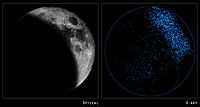
"Lunar X-rays are thought to be produced by the scattering or fluorescence of solar X-rays from the Moon's surface (Schmitt et al., 1991)."[28]
X-rays from the dark moon, or shadowed portion of the Moon, can be explained by radiation from Earth's geocorona (extended outer atmosphere) through which orbiting spacecraft such as the Chandra X-ray Observatory move.
The Chandra X-ray Observatory has detected X-rays from oxygen, magnesium, aluminum and silicon atoms on the Moon.[29]
Ultraviolets
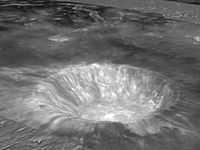
"In 1911, Professor Robert W. Wood used ultraviolet photography to take images of the crater area. He discovered the plateau had an anomalous appearance in the ultraviolet, and an area to the north appeared to give indications of a sulfur deposit.[30] This colorful area is sometimes referred to as "Wood's Spot", an alternate name for the Aristarchus Plateau."[31]
"Spectra taken of this crater during the Clementine mission were used to perform mineral mapping.[32] The data indicated that the central peak is a type of rock called anorthosite, which is a slow-cooling form of igneous rock composed of plagioclase feldspar. By contrast the outer wall is troctolite, a rock composed of equal parts plagioclase and olivine."[31]
"The Aristarchus region was part of a Hubble Space Telescope study in 2005 that was investigating the presence of oxygen-rich glassy soils in the form of the mineral ilmenite. Baseline measurements were made of the Apollo 15 and Apollo 17 landing sites, where the chemistry is known, and these were compared to Aristarchus. The Hubble Advanced Camera for Surveys was used to photograph the crater in visual and ultraviolet light. The crater was determined to have especially rich concentrations of ilmenite, a titanium oxide mineral that could potentially be used in the future by a lunar settlement for extracting oxygen.[33]"[31]
Opticals
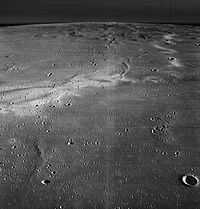
"Comet impacts over the past 100 million years can account for many of the features in the mysterious lunar swirls – wispy bright regions scattered on the lunar surface."[34]
"The Reiner Gamma formation [in the image on the right] is a well known lunar swirl region, due to its nearside location. Swirls are described by curving, diffuse bright patterns, which are interspersed with darker lanes. These anomalous albedo patterns are associated with local magnetic anomalies of varying intensities; swirl complexes are often extensive and may stretch across thousands of kilometers, well beyond localized magnetic anomalies."[34]
"Reiner Gamma can be seen by telescope on the southwestern corner of the Moon’s near side."[34]
“We think this makes a pretty strong case that the swirls represent remnants of cometary collisions.”[35]
“At first glance, the swirls do not appear to be related to large impact craters or any other topography. They simply look as if someone had finger-painted the surface. There has been an intense debate about what causes these features.”[35]
“You could see that the whole area around the lunar modules was smooth and bright because of the gas from the engines scoured the surface. That was part of what got me started thinking comet impacts could cause the swirls.”[35]
"The simulations showed that the impact of a comet coma plus its icy core would indeed have the effect of blowing away the smallest grains that sit atop the lunar soil."[34]
"The comet impact hypothesis could also explain the presence of magnetic anomalies near the swirls. The simulations showed that a comet impact would melt some of the tiny particles near the surface. When small, iron-rich particles are melted and then cooled, they record the presence of any magnetic field that may be present at the time."[34]
Visuals
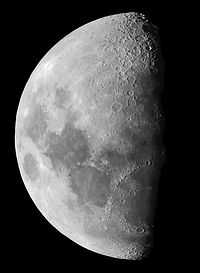
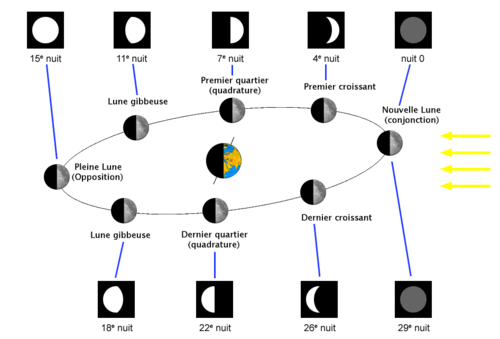
"The overall albedo of the Moon is around 0.12, but it is strongly directional and non-Lambertian, displaying also a strong opposition effect.[36]"[37]
The centered diagram describes how the Moon's phases are produced by the relative positions of the Moon, the Earth and the Sun in space.
The Moon presents the appearance a thin crescent at twilight or at dawn when it is located between the Earth and the Sun; a half disc for half of the night when it is the same distance from the Sun as our planet and finally a complete disc all night long when it is opposite the Sun in relation to the Earth. The sight of the setting crescent Moon against blue sky at twilight is well worth staying up late for.
The effect of the path of its illuminating solar rays can also be seen: in its first rising phase or its final setting phase, when it is only a crescent, one can often see the dark part of its disk weakly illuminated, permitting us to distinguish the form of the complete disc. This is due to the solar rays falling on the Earth reflecting toward the Moon and illuminating the side that is in darkness. This long route makes for a weak light reaching us, but it is sufficient to distinguish it.
Violets
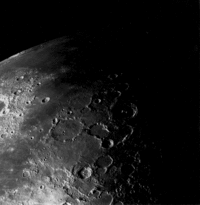
"Checking out the Galileo spacecraft's cameras during its December 1992 flyby of Earth's Moon, controllers took this dramatically illuminated picture [at right] through a violet filter. The view looks down on the Moon's north polar region with the Sun shining from the left at a low angle and the direction toward the moon's North pole toward the lower right. Across the image upper left stretches the smooth volcanic plain of the Mare Imbrium. Pythagoras crater, 65 miles wide, is near the center of the image -- mostly in shadow, its central peak just catches the sunlight. Yesterday, the Moon made its closest approach to Earth and was full for the second time in July (as reckoned by UT dates). The closest point in the Moon's orbit is referred to as Lunar Perigee, a mere 221,797 miles at 8 hours UT. The second full moon in a month is known as a "Blue Moon"."[38]
Blues
"Nine out of 10 well-characterized Apollo 17 breccia matrices fall into Group 2, and this includes both the blue-grey breccias which are the dominant rock type at this site"[39].
"A 1953 telescopic photograph of a flash on the Moon is the only unequivocal record of the rare crash of an asteroid-sized body onto the lunar surface. ... A search of images from the Clementine mission reveals an ∼1.5-km high-albedo, blue, fresh-appearing crater with an associated ejecta blanket at the location of the flash."[40]
In terms of reflectance from the lunar surface, "the very dark 'blue' maria [are] such as found in Mare Tranquillitatis."[41]
"[T]he slope of the reflectance spectrum in the blue and ultraviolet ... is directly related to the percent TiO2 in the [lunar] surface soil (Charette et al., 1974)."[42]
Cyans
“[A]ll the blue basalt types (high in UV/VIS ratio [0.40/0.56 µm]) are also the darkest mare soils.”[43] Both Luna 24 and Apollo 12 soil samples are from mare soils that reflect primarily cyan that is likely due to the presence of TiO2 in the soils.[42]
"Previous work has suggested that a cyan color in the multispectral frame represents highland material, and that yellows and greens are freshly excavated basalts. However, we have recently found that a cyan color can also result from a freshly excavated high-Ti basalt."[44]
Greens
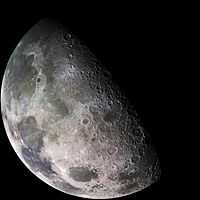
"During its mission, the Galileo spacecraft returned a number of images of Earth's only natural satellite. Galileo surveyed the moon on Dec. 7, 1992, on its way to explore the Jupiter system in 1995-1997."[45]
"This color mosaic was assembled from 18 images taken by Galileo's imaging system through a green filter. On the upperleft is the dark, lava-filled Mare Imbrium, Mare Serenitatis (middle left), Mare Tranquillitatis (lower left), and Mare Crisium, the dark circular feature toward the bottom of the mosaic. Also visible in this view are the dark lava plains of the Marginis and Smythii Basins at the lower right. The Humboldtianum Basin, a 400-mile impact structure partly filled with dark volcanic deposits, is seen at the center of the image."[45]
Oranges

"Crystallized spheres of orange glass from Shorty Crater at the Apollo 17 site are ... the characteristic ingredient of the dark mantling deposit of the Taurus-Littrow region."[46]
"The reflectance properties of the orange glass are highly distinctive. There are two broad absorption bands, one near 1.15 µm and the other near 1.9 µm that arise from Fe2+ on octahedral and tetrahedral sites, respectively ... The weak absorption near 0.5 µm probably arises from Ti3+, and the absorption edge extending into the visible region is due largely to oxygen-titanium charge transfer".[46]
In the image at the right, the Moon turns red and orange during a total lunar eclipse on October 27, 2004. With the Earth passing between the Sun and the Moon, the only light hitting the full moon was from the home planet's sunrises and sunsets, resulting in the orange and red hue.
Reds
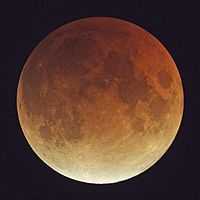
.jpg)
"During a lunar eclipse, a very small amount of light from the sun does however still reach the Moon, even when the lunar eclipse is total; this is light which has been refracted or bent as it passes through the Earth's atmosphere. This sunlight has been scattered by the dust in the Earth's atmosphere, and thus that light is red, in the same way that sunset and sunrise light is red. This weak red illumination is what causes the eclipsed Moon to be dimly reddish or copper-colored in appearance.[47]"[48]
"This image of the crescent Moon [at left] shows sunlight skimming across the heavily pocked surface, filling its craters with shadows. This is a fairly flat region of the Moon, but elsewhere, high mountains can be found, with some peaks reaching about 5000 metres. When backlit by the Sun, these mountains cast long shadows on the lunar surface."[49]
"This view of the Moon was taken through a narrowband red filter (H-alpha). The height of the image is about 30 arcminutes."[49]
"The MPG/ESO 2.2-metre telescope at La Silla in Chile is a powerful instrument that can capture distant celestial objects, but it has been used here to image a heavenly body that is much closer to home: the Moon."[49]
Infrareds



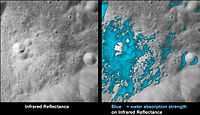
"Four radiometers [aboard Luna 13 ] recorded infrared radiation from the [Moon's] surface indicating a noon temperature of 117 ±3 °C"[50].
"An infrared camera image from the moon is taken with the Lunar Crater Observation and Sensing Satellite (LCROSS) mid-infrared camera. LCROSS has nine science instruments that collect different types of data which are complementary to each other. These instruments provide for a robust collection of data about the composition of the lunar regolith."[51] "On the 9th of October, 2009, the Diviner team announced[52] detection of a hot spot on the moon at the location of the LCROSS impact."[53]
"Frank Washington Very's most important work was in measuring the temperature of the [surface] of the Moon using a bolometer. Samuel Pierpont Langley published in 1890 a widely read paper on the Moon observations, but for unknown reasons omitted Very's name from the list of authors. In 1891, Very published his own paper about the "Distribution of the Moon's Heat," which also included measurements taken during a lunar eclipse."[54]
"NASA's Moon Mineralogy Mapper, an instrument on the Indian Space Research Organization's Chandrayaan-1 mission, took [the image at right] of Earth's moon. It is a three-colour composite of reflected near-infrared radiation from the sun, and illustrates the extent to which different materials are mapped across the side of the moon that faces Earth. Small amounts of water were detected on the surface of the moon at various locations. This image illustrates their distribution at high latitudes toward the poles. Blue shows the signature of water, green shows the brightness of the surface as measured by reflected infra-red radiation from the sun and red shows a mineral called pyroxene."[55]
"Blue shows the signature of water, green shows the brightness of the surface as measured by reflected infrared radiation from the sun and red shows an iron-bearing mineral called pyroxene."[55]
"Small amounts of water were detected on the surface of the moon at various locations. This image illustrates their distribution at high latitudes toward the poles."[55]
"These images show a very young lunar crater on the side of the moon that faces away from Earth, as viewed by NASA's Moon Mineralogy Mapper [M3] on the Indian Space Research Organization's Chandrayaan-1 spacecraft. On the left is an image showing brightness at shorter infrared wavelengths. On the right, the distribution of water-rich minerals (light blue) is shown around a small crater. Both water- and hydroxyl-rich materials were found to be associated with material ejected from the crater."[56]
"The mid-infrared image of the Moon [at left] was taken during a 1996 lunar eclipse by the SPIRIT-III instrument aboard the orbiting Midcourse Space Experiment satellite. At these wavelengths, MSX was able to characterize the thermal (heat) distribution of the lunar surface during the eclipse. The brightest regions are the warmest, and the darkest areas are the coolest. The well-known crater Tycho is the bright object to the south of center. Numerous other craters are also seen as bright spots, indicating that their temperature is higher than in the surrounding dark mare. The Moon is geologically inactive for the most part, and any temperature differences are a result primarily of variations in solar heating (rather than volcanoes, for example). The Moon lacks an atmosphere to moderate temperatures, which can vary from 130 degrees Celsius (265 degrees Fahrenheit) in the sun to -110 degrees Celcius (-170 degrees Fahrenheit) in the shade."[57]
"M3 found a rock dominated by Mg-spinel with no detectable pyroxene or olivine present (<5%) occurring along the western inner ring of Moscoviense Basin (as one of several discrete areas). The occurrence of this spinel does not easily fit with current lunar-crustal evolution models.[58]"[59]
Radars
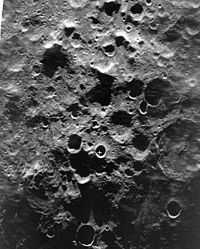

"The moon is comparatively close and was detected by radar, soon after the invention of the technique, in 1946.[60][61] Measurements included surface roughness and later mapping of shadowed regions near the poles."[62]
"Clementine orbited the Moon in 1994 for 71 days, mapping the Moon globally in 11 wavelengths and measuring its topography by laser ranging. [... The] bistatic radar experiment (so-called because the spacecraft transmitted while we listened to the echoes on Earth) found evidence in the dark areas near the south pole of the Moon for material with high circular polarization ratio [CPR]".[63]
"Meanwhile, astronomers on Earth began publishing results questioning the Clementine and Lunar Prospector [1998-2000] results. With the giant Arecibo radiotelescope, radar images were taken from the Earth. They found radar reflections with high CPR lying in both permanent darkness and in sunlit areas. Ice is not stable in sunlight, so they postulated that all high CPR is caused by surface roughness; if any ice is at the lunar poles, it must be in a finely disseminated form, invisible to radar mapping."[63]
The experiment from Clemintine "was bistatic, i.e., the transmitter and receiver were in different places. Bistatic radar has the advantage of observing reflections through the phase angle, the angle between transmitted and received radio rays [...]. This phase dependence is important. It’s similar to the effect one gets from looking at a bicycle reflector at just the right angle: at certain angles, the internal planes in the transparent plastic align and a very bright reflection is seen. Similarly, in both radio and visible wavelengths on the Moon, we see an “opposition surge”, an apparent increase in brightness looking directly down from the sun (zero phase). Clementine orbited the Moon such that we could observe its phase dependence [...] and we specifically looked for this “opposition surge”, called the Coherent Backscatter Opposition Effect (CBOE). CBOE is particularly valuable to identify ice on planetary surfaces."[63]
"Clementine transmitted right circular polarized (RCP) radio and we listened on Earth in both right- and left-circular polarized (LCP) channels. The ratio of power received in these two channels is called the circular polarization ratio (CPR). The dry, equatorial Moon has CPR less than one, but the icy satellites of Jupiter all have CPR greater than one. We know these objects have surfaces of water ice; in this case, the ice acts as a radio-transparent media in which waves penetrate the ice, are scattered and reflected multiple times, and returned such that some of the waves are received in the same polarization sense as they are sent—they have CPR greater than unity"[63]
"The problem with CPR alone is that we can also get high values from very rough surfaces, such as a rough, blocky lava flow, which has angles that form many small corner reflectors. In this case, a radio wave could hit a rock face (changing RCP into LCP) and then bounce over to another rock face (changing the LCP back into RCP) and hence to the receiver [...]. This “double-bounce” effect also creates high CPR in that “same sense” reflections could mimic the enhanced CPR one gets from ice targets."[63]
At lower right is an image using the Goldstone DSS-14 antenna as a transmitter and the DSS-13 as a receiver, a form of radar interferometry. The cross for the south pole in the Arecibo image is in the Shackleton crater of the Goldstone image.
Radios
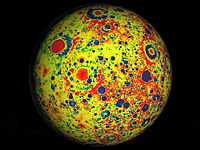
"The moon is comparatively close and was detected by radar, soon after the invention of the technique, in 1946.[60][64] Measurements included surface roughness and later mapping of shadowed regions near the poles."[62]
"Very precise microwave measurements between two spacecraft, named Ebb and Flow, were used to map gravity with high precision and high spatial resolution. The field shown resolves blocks on the surface of about 12 miles (20 kilometres) and measurements are three to five orders of magnitude improved over previous data. Red corresponds to mass excesses and blue corresponds to mass deficiencies. The map shows more small-scale detail on the far side of the moon compared to the nearside because the far side has many more small craters."[65]
"Twin NASA probes orbiting Earth's moon have generated the highest resolution gravity field map of any celestial body. The new map, created by the Gravity Recovery and Interior Laboratory (GRAIL) mission, is allowing scientists to learn about the moon's internal structure and composition in unprecedented detail. Data from the two washing machine-sized spacecraft also will provide a better understanding of how Earth and other rocky planets in the solar system formed and evolved."[65]
"The gravity field map reveals an abundance of features never before seen in detail, such as tectonic structures, volcanic landforms, basin rings, crater central peaks and numerous simple, bowl-shaped craters. Data also show the moon's gravity field is unlike that of any terrestrial planet in our solar system."[66]
""What this map tells us is that more than any other celestial body we know of, the moon wears its gravity field on its sleeve," said GRAIL Principal Investigator Maria Zuber of the Massachusetts Institute of Technology in Cambridge. "When we see a notable change in the gravity field, we can sync up this change with surface topography features such as craters, rilles or mountains.""[66]
"According to Zuber, the moon's gravity field preserves the record of impact bombardment that characterized all terrestrial planetary bodies and reveals evidence for fracturing of the interior extending to the deep crust and possibly the mantle. This impact record is preserved, and now precisely measured, on the moon. The probes revealed the bulk density of the moon's highland crust is substantially lower than generally assumed. This low-bulk crustal density agrees well with data obtained during the final Apollo lunar missions in the early 1970s, indicating that local samples returned by astronauts are indicative of global processes."[66]
""With our new crustal bulk density determination, we find that the average thickness of the moon's crust is between 21 and 27 miles (34 and 43 kilometres), which is about 6 to 12 miles (10 to 20 kilometres) thinner than previously thought," said Mark Wieczorek, GRAIL co-investigator at the Institut de Physique du Globe de Paris. "With this crustal thickness, the bulk composition of the moon is similar to that of Earth. This supports models where the moon is derived from Earth materials that were ejected during a giant impact event early in solar system history.""[66]
"The map was created by the spacecraft transmitting radio signals to define precisely the distance between them as they orbit the moon in formation. As they fly over areas of greater and lesser gravity caused by visible features, such as mountains and craters, and masses hidden beneath the lunar surface, the distance between the two spacecraft will change slightly."[66]
""We used gradients of the gravity field in order to highlight smaller and narrower structures than could be seen in previous datasets," said Jeff Andrews-Hanna, a GRAIL guest scientist with the Colorado School of Mines in Golden. "This data revealed a population of long, linear gravity anomalies, with lengths of hundreds of kilometres, crisscrossing the surface. These linear gravity anomalies indicate the presence of dikes, or long, thin, vertical bodies of solidified magma in the subsurface. The dikes are among the oldest features on the moon, and understanding them will tell us about its early history.""[66]
Rocks/Glaciers/Astroglaciology
"The discoveries of water ice on the Moon, Mars and Europa add an extraterrestrial component to the field, as in "astroglaciology".[12]"[67]
Craters
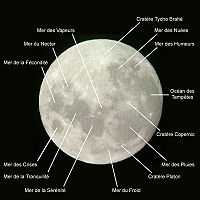
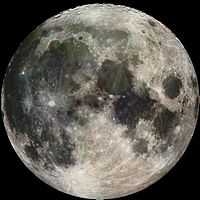
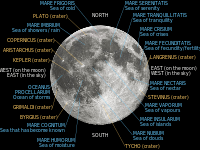
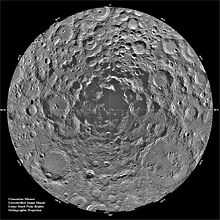
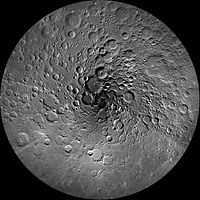
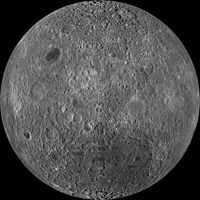
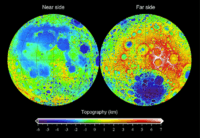

Lunar craters "are pits or depressions in the surface of the Moon, produced by great impacts of gigantic meteoroids which mostly took place billions of years ago. They range in size from huge walled plains more than a hundred miles across to microscopic pits. The smallest craters which can be glimpsed through ordinary binoculars are about twenty miles across. These craters are most common in the light-colored Lunar highlands. They are named after historical figures, mostly scientists."[68]
"During its flight, the Galileo spacecraft returned images of the Moon. The Galileo spacecraft took these images on December 7, 1992 on its way to explore the Jupiter system in 1995-97. The distinct bright ray crater at the bottom of the image is the Tycho impact basin. The dark areas are lava rock filled impact basins: Oceanus Procellarum (on the left), Mare Imbrium (center left), Mare Serenitatis and Mare Tranquillitatis (center), and Mare Crisium (near the right edge). This picture contains images through the Violet, 756 nm, 968 nm filters. The color is 'enhanced' in the sense that the CCD camera is sensitive to near infrared wavelengths of light beyond human vision."[69]
The dark irregular mare lava plains are prominent in the fully illuminated disk. A single bright star of ejecta, with rays stretching a third of the way across the disk, emblazons the lower centre: this is the crater Tycho on the Near side of the Moon. But, on the far side, the full disk is nearly featureless, a uniform grey surface with almost no dark mare. There are many bright overlapping dots of impact craters. And, an almost complete lack of dark maria.[70]
"The topography of the Moon has been measured with laser altimetry [using the sodium D2 line in the yellow] and stereo image analysis.[63] The most visible topographic feature is the giant far side South Pole – Aitken basin, some 2,240 km in diameter, the largest crater on the Moon and the largest known crater in the Solar System.[71][72] At 13 km deep, its floor is the lowest elevation on the Moon.[71][73] The highest elevations are found just to its north-east, and it has been suggested that this area might have been thickened by the oblique formation impact of South Pole – Aitken.[35] Other large impact basins, such as Imbrium, Serenitatis, Crisium, Smythii, and Orientale, also possess regionally low elevations and elevated rims.[71] The lunar far side is on average about 1.9 km higher than the near side.[74]"[75]
"These images show a very young lunar crater on the side of the moon that faces away from Earth, as viewed by NASA's Moon Mineralogy Mapper [M3] on the Indian Space Research Organization's Chandrayaan-1 spacecraft. On the left is an image showing brightness at shorter infrared wavelengths. On the right, the distribution of water-rich minerals (light blue) is shown around a small crater. Both water- and hydroxyl-rich materials were found to be associated with material ejected from the crater."[56]
"Unusual minerals in impact craters on the moon may not have originated on the moon, but may be from asteroids that created the craters"[76]
"Future studies of the moon's composition will have to show that exposed surface rocks really come from the moon and were not delivered by impacts, especially for unusual or exotic minerals ... "We cannot infer the deep composition of the moon from rocks in the centers of large craters without more care than has been used to date".[77]
"[C]omputer models [have been used] to simulate the formation of lunar craters by asteroid impacts and ... [in] some impacts much of the asteroid's material is not vaporized but is instead deposited in the center of the impact craters."[76]
Meteorites
Def. "a meteorite that is known to have originated on the Moon" is called a lunar meteorite.[9]
The meteorite "called Allan Hills 81005 ... resembled some rocks brought back from the Moon by the Apollo program.[78]"[9]
Yamato 791197 is another lunar meteorite.
"About 134 lunar meteorites have been discovered so far (as of October, 2010), perhaps representing more than 50 separate meteorite falls (i.e., many of the stones are "paired" fragments of the same meteoroid). The total mass is more than 46 kg."[9]
Meteorites have been found on the Moon[79][80]
Many of the meteorites that are found on Earth turn out to be from the Moon.
So far seifertite "has only been found in Martian[81][82] and lunar meteorites[83]".[84]
Classical planets
Monday is the day of the week for the Moon and its color is white.[85]
5102 b2k, is the historical year assigned to a Hindu table of planets that does include the classical planet, the Moon.[86]
~2500 b2k: “Understanding of the Moon's cycles was an early development of astronomy: by the 5th century BC, Babylonian astronomers had recorded the 18-year Saros cycle of lunar eclipses,[87] ”[75]
“Indian astronomers had described the Moon’s monthly elongation.[88]”[75]
“The Chinese astronomer Shi Shen (fl. 4th century BC) gave instructions for predicting solar and lunar eclipses.[89] ... Although the Chinese of the Han Dynasty believed the Moon to be energy equated to qi, their 'radiating influence' theory also recognized that the light of the Moon was merely a reflection of the Sun, and Jing Fang (78–37 BC) noted the sphericity of the Moon.[89]”[75]
“Later, the physical form of the Moon and the cause of moonlight became understood. The ancient Greek philosopher Anaxagoras (d. 428 BC) reasoned that the Sun and Moon were both giant spherical rocks, and that the latter reflected the light of the former.[90][89]”[75]
Aphrodite
""Foam-born" Aphrodite is linked to the Moon through her epithet Pasiphaessa, the 'All-shinig One'. In Hesiod's Theogony, Aphrodite was conceived in the lap of the waves which were fertilized by semen from the severed genitals of Ouranos, Heaven, and was 'born in soft foam', as the Homeric Hymn to Aphrodite puts it.71"[91]
Research
Hypothesis:
- The Moon did not originate in orbit around the Earth.
Control groups

The findings demonstrate a statistically systematic change from the status quo or the control group.
“In the design of experiments, treatments [or special properties or characteristics] are applied to [or observed in] experimental units in the treatment group(s).[92] In comparative experiments, members of the complementary group, the control group, receive either no treatment or a standard treatment.[93]"[94]
Proof of concept
Def. a “short and/or incomplete realization of a certain method or idea to demonstrate its feasibility"[95] is called a proof of concept.
Def. evidence that demonstrates that a concept is possible is called proof of concept.
The proof-of-concept structure consists of
- background,
- procedures,
- findings, and
- interpretation.[96]
See also
References
- 1 2 3 Samuel J. Johnson (1874). "Occultations of and by Venus". Astronomical register 12: 268-70.
- ↑ Kocharov, G. E.; Viktorov, S. V.; Victorov, S. V.; Chesnokov, V. I. (1975). "Investigation of solar X-rays from the lunar surface, carried out on Lunokhod-2". Space Research 15: 633-6.
- 1 2 3 Douglas Quenqua (July 30, 2014). "The Moon Is (Slightly) Flat, Scientists Say". New York City, New York, USA: The New York Times. Retrieved 2014-09-06.
- 1 2 3 Ian Garrick-Bethell (July 30, 2014). "The Moon Is (Slightly) Flat, Scientists Say". New York City, New York, USA: The New York Times. Retrieved 2014-09-06.
- ↑ Charles Q. Choi (04 December 2014). "Moon's Long-Ago Magnetic Field May Have Trumped Earth's". Space.com. Retrieved 2014-12-09.
- ↑ Benjamin Weiss (04 December 2014). "Moon's Long-Ago Magnetic Field May Have Trumped Earth's". Space.com. Retrieved 2014-12-09.
- ↑ Elizabeth Gibney (01 October 2014). "Moon's largest plain is not an impact crater". Nature.com. Retrieved 2014-10-02.
- ↑ Jeffrey Andrews-Hanna (01 October 2014). "Moon's largest plain is not an impact crater". Nature.com. Retrieved 2014-10-02.
- 1 2 3 4 5 6 "Lunar meteorite, In: Wikipedia". San Francisco, California: Wikimedia Foundation, Inc. August 30, 2012. Retrieved 2012-09-28.
- ↑ Mike Wall (May 22, 2013). "Big Meteor Explosion on Moon Shows Lunar Exploration Risks". Yahoo! News. Retrieved 2013-05-22.
- ↑ Bill Cooke (May 22, 2013). "Big Meteor Explosion on Moon Shows Lunar Exploration Risks". Yahoo! News. Retrieved 2013-05-22.
- 1 2 3 4 5 6 7 David R. Williams (November 2011). "Lunar Prospector Neutron Spectrometer (NS)". Goddard Space Flight Laboratory: National Aeronautics and Space Administration. Retrieved 2012-01-11.
- ↑ Eugene Cernan (August 22, 2011). "Deep Core, In: APOLLO 17 LUNAR SURFACE JOURNAL". Washington, DC USA: NASA. Retrieved 2012-08-18.
- 1 2 Dave Shaffer (August 22, 2011). "Deep Core, In: APOLLO 17 LUNAR SURFACE JOURNAL". Washington, DC USA: NASA. Retrieved 2012-08-18.
- 1 2 "Apollo 11 Mission". Lunar and Planetary Institute. 2009. Retrieved 2009-06-12.
- ↑ "Space Travel and Cancer Linked? Stony Brook Researcher Secures NASA Grant to Study Effects of Space Radiation". Brookhaven National Laboratory. 12 December 2007. Retrieved 2009-06-12.
- ↑ Bhardwaj, A.; Barabash, S.; Futaana, Y.; Kazama, Y.;Asamura, K.; McCann, D.; Sridharan, R.; Holmstrom, .; Wurz, P.; Lundin, R.; (December 2005). "Low energy neutral atom imaging on the Moon with the SARA instrument aboard Chandrayaan-1 mission". J. Earth Syst. Sci. 114 (6): 749–760. doi:10.1007/BF02715960. http://www.ias.ac.in/jessci/dec2005/ilc-21.pdf. Retrieved 2009-11-01.
- ↑ /releases/2009/10/091015091605.htm "How The Moon Produces Its Own Water". European Space Agency. ScienceDaily. 2009-10-19. Retrieved 2009=11-01.
- ↑ "Energetic neutral atom, In: Wikipedia". San Francisco, California: Wikimedia Foundation, Inc. August 4, 2012. Retrieved 2012-09-26.
- ↑ Borisov, N.; Mall, U. "The structure of the double layer behind the Moon" (2002) Journal of Plasma Physics, vol. 67, Issue 04, pp. 277–299
- ↑ Halekas, J. S.; Lin, R. P.; Mitchell, D. L. "Inferring the scale height of the lunar nightside double layer" (2003) Geophysical Research Letters, Volume 30, Issue 21, pp. PLA 1-1. (PDF)
- ↑ Halekas, J. S et al. "Evidence for negative charging of the lunar surface in shadow" (2002) Geophysical Research Letters, Volume 29, Issue 10, pp. 77–81
- ↑ "Lunar Prospector, In: Wikipedia". San Francisco, California: Wikimedia Foundation, Inc. August 12, 2012. Retrieved 2012-08-12.
- ↑ J. S. Halekas, R. P. Lin, D. L. Mitchell (November 2003). "Inferring the scale height of the lunar nightside double layer". Geophysical Research Letters 30 (21): 4. doi:10.1029/2003GL018421.
- ↑ "CGRO SSC >> EGRET Detection of Gamma Rays from the Moon". Heasarc.gsfc.nasa.gov. 2005-08-01. Retrieved 2011-11-08.
- ↑ D. J. Lawrence, * W. C. Feldman, B. L. Barraclough, A. B. Binder, R. C. Elphic, S. Maurice, D. R. Thomsen (1998). "Global Elemental Maps of the Moon: The Lunar Prospector Gamma-Ray Spectrometer". Science 281 (5382): 1484–1489. doi:10.1126/science.281.5382.1484. PMID 9727970.
- 1 2 "Gamma ray spectrometer, In: Wikipedia". San Francisco, California: Wikimedia Foundation, Inc. December 11, 2011. Retrieved 2012-06-09.
- ↑ T. E. Cravens (2000). "X-ray emission from comets and planets". Advances in Space Research 26 (10): 1443-51. doi:0.1016/S0273-1177(00)00100-9. http://www.sciencedirect.com/science/article/pii/S0273117700001009. Retrieved 2012-01-11.
- ↑ Robert Burnham (2004). Moon Prospecting. Kalmbach Publishing Co.. http://elibrary.ru/item.asp?id=7602287. Retrieved 2012-01-11.
- ↑ David O. Darling. "Aristarchus: Lunar Transient Phenomenon History". L.T.P. Research. Retrieved 2006-08-08.
- 1 2 3 "Aristarchus (crater), In: Wikipedia". San Francisco, California: Wikimedia Foundation, Inc. March 27, 2013. Retrieved 2013-06-30.
- ↑ "Aristarchus Region: Multispectral Mosaic of the Aristarchus Crater and Plateau". Lunar and Planetary Institute. Retrieved 2006-08-08.
- ↑ Jeffrey Kluger (2005-10-20). "Is There Oxygen on the Moon?". Time Online. Retrieved October 24, 2005.
- 1 2 3 4 5 Megan Bruck Syal & Peter H. Schultz (3 June 2015). "Comet Collisions Could Explain Formation of Mysterious Lunar Swirls". Sci-News. Retrieved 2015-06-21.
- 1 2 3 4 Peter H. Schultz (3 June 2015). "Comet Collisions Could Explain Formation of Mysterious Lunar Swirls". Sci-News. Retrieved 2015-06-21.
- ↑ Jeffrey S. Medkeff (2002). "Lunar Albedo". Retrieved 5 July 2010.
- ↑ "Albedo, In: Wikipedia". San Francisco, California: Wikimedia Foundation, Inc. April 24, 2013. Retrieved 2013-05-01.
- ↑ Robert Nemiroff & Jerry Bonnell (July 31, 1996). "Astronomy Picture of the Day". Washington, DC USA: NASA. Retrieved 2013-04-01.
- ↑ John W. Morgan, H. Higuchi, and Edward Anders (November-December 1975). "Meteoritic material in a boulder from the Apollo 17 site - Implications for its origin". The Moon 14 (12): 373-83. doi:10.1007/BF00569671.
- ↑ Bonnie J Buratti, Lane L Johnson (January 2003). "Identification of the lunar flash of 1953 with a fresh crater on the moon’s surface". Icarus 161 (1): 192-7. doi:10.1016/S0019-1035(02)00027-1. http://www.sciencedirect.com/science/article/pii/S0019103502000271. Retrieved 2012-11-27.
- ↑ Thomas B. McCord and John B. Adams (September 1973). "Progress in remote optical analysis of lunar surface composition". The Moon 7 (3-4): 453-74. doi:10.1007/BF00564646.
- 1 2 Carle Pieters and Thomas B. McCord (April 1976). Characterization of lunar mare basalt types. I - A remote sensing study using reflection spectroscopy of surface soils, In: Proceedings Lunar Science Conference, 7th. 3. New York: Pergamon Press, Inc.. pp. 2677-90.
- ↑ Carle’ M. Pieters. Mare basalt types on the front side of the moon - A summary of spectral reflectance data, In: Lunar and Planetary Science Conference, 9th, Houston, Tex., March 13-17, 1978, Proceedings. 3. New York: Pergamon Press, Inc.. pp. 2825-49. Bibcode: 1978LPSC....9.2825P.
- ↑ D. J. Heather, S. K. Dunkin, P. D. Spudis, D. B. J. Bussey (January 1999). A Multispectral Analysis of the Flamsteed Region of Oceanus Procellarum, In: Workshop on New Views of the Moon 2: Understanding the Moon Through the Integration of Diverse Datasets. Bibcode: 1999nvm..conf...24H.
- 1 2 Yvette Smith (December 8, 2009). "Earth's Moon". NASA. Retrieved 2012-07-22.
- 1 2 John B. Adams, Carle Pieters, and Thomas B. McCord (March 18-22 1974). Orange glass: Evidence for regional deposits of pyroclastic origin on the moon, In: Proceedings of the Fifth Lunar Science Conference. 1. New York: Pergamon Press, Inc.. pp. 171-86.
- ↑ David K. Lynch, William Charles Livingston (July 2001). Color and light in nature. Cambridge University Press; 2 edition. p. 38,39. ISBN 978-0-521-77504-5. http://books.google.com/books?id=4Abp5FdhskAC&pg=PA38&lpg=PA38&source=bl&ots=bN3UHSoym0&sig=DIeWBajGeM4ecoPW1KKNmhLyaV0&hl=en&ei=pFe8TLjoLJGqsAPcsemzDw&sa=X&oi=book_result&ct=result&resnum=1&ved=0CBIQ6AEwAA#v=onepage&f=false.
- ↑ "Earth's shadow, In: Wikipedia". San Francisco, California: Wikimedia Foundation, Inc. February 28, 2013. Retrieved 2013-05-30.
- 1 2 3 Andy Strappazzon (July 18, 2011). "Hidden Treasure on Our Doorstep". La Silla, Chile: ESO. Retrieved 2013-07-28.
- ↑ "Luna 13, In: Wikipedia". San Francisco, California: Wikimedia Foundation, Inc. September 5, 2012. Retrieved 2012-09-26.
- ↑ "File:Mid infrared camera image of the moon by LCROSS.jpg". Wikimedia Commons (San Francisco, California: Wikimedia Foundation, Inc). October 10, 2009. http://commons.wikimedia.org/wiki/File:Mid_infrared_camera_image_of_the_moon_by_LCROSS.jpg. Retrieved 2012-09-26.
- ↑ http://www.diviner.ucla.edu/blog/?p=184
- ↑ "Diviner, In: Wikipedia". San Francisco, California: Wikimedia Foundation, Inc. October 25, 2011. Retrieved 2012-09-26.
- ↑ "Frank Washington Very, In: Wikipedia". San Francisco, California: Wikimedia Foundation, Inc. June 3, 2012. Retrieved 2012-09-26.
- 1 2 3 Yvette Smith (September 25, 2009). "Water Detected at High Latitudes on the Moon". NASA. Retrieved 2012-09-26.
- 1 2 Jim Wilson (September 24, 2009). "Water Around a Fresh Crater". NASA. Retrieved 2012-09-26.
- ↑ DCATT Team (1996). "MSX Showcase A Gallery of Infrared Images". Pasadena, California USA: California Institute of Technology. Retrieved 2013-08-02.
- ↑ Pieters, Carle. "Identification of a new spinel-rich lunar rock type by the Moon Mineralogy Mapper (M3)". LPI. Retrieved 12 April 2011.
- ↑ "Moon Mineralogy Mapper, In: Wikipedia". San Francisco, California: Wikimedia Foundation, Inc. July 12, 2012. Retrieved 2012-09-26.
- 1 2 J. Mofensen (February, April 1946). "Radar Echoes from the Moon". Nature, Electronics 157, 19 (3379): 129, 92-8. doi:10.1038/157129b0.
- ↑ Z. Bay, "Reflection of microwaves from the moon," Hung. Acta Phys., vol. 1, pp. 1-22; April, 1946.
- 1 2 "Radar astronomy, In: Wikipedia". San Francisco, California: Wikimedia Foundation, Inc. July 30, 2012. Retrieved 2012-08-30.
- 1 2 3 4 5 6 P. Spudis (November 6, 2006). "Ice on the Moon". The Space Review. Retrieved 12 April 2007.
- ↑ Z. Bay, "Reflection of microwaves from the moon," Hung. Acta Phys., vol. 1, pp. 1-22; April, 1946.
- 1 2 Tony Greicius (December 6, 2012). "GRAIL's Gravity Map of the Moon". NASA/JPL-Caltech/MIT/GSFC. Retrieved 2012-12-15.
- 1 2 3 4 5 6 PR Newswire (December 5, 2012). "NASA Twin Spacecraft Create Most Accurate Gravity Map Of Moon". Retrieved 2012-12-15.
- ↑ "Glaciology, In: Wikipedia". San Francisco, California: Wikimedia Foundation, Inc. March 30, 2013. Retrieved 2013-06-23.
- ↑ Fountains of Bryn Mawr (October 30, 2008). "Skygazing, In: Wikiversity". Retrieved 2013-03-30.
- ↑ Jon Nelson (June 8, 1998). "Earth's Moon". NASA/JPL/USGS. Retrieved 2012-09-26.
- ↑ "Landscapes from the ancient and eroded lunar far side". esa. Retrieved 15 February 2010.
- 1 2 3 Spudis, Paul D.; Reisse, Robert A.; Gillis, Jeffrey J. (1994). "Ancient Multiring Basins on the Moon Revealed by Clementine Laser Altimetry". Science 266 (5192): 1848–1851. doi:10.1126/science.266.5192.1848. PMID 17737079.
- ↑ Pieters, C.M.; Tompkins, S.; Head, J.W.; Hess, P.C. (1997). "Mineralogy of the Mafic Anomaly in the South Pole‐Aitken Basin: Implications for excavation of the lunar mantle". Geophysical Research Letters 24 (15): 1903–6. doi:10.1029/97GL01718. http://www.agu.org/pubs/crossref/1997/97GL01718.shtml.
- ↑ Taylor, G.J. (17 July 1998). "The Biggest Hole in the Solar System". Planetary Science Research Discoveries, Hawai'i Institute of Geophysics and Planetology. Retrieved 12 April 2007.
- ↑ Wieczorek, M. et al. (2006). "The constitution and structure of the lunar interior". Reviews in Mineralogy and Geochemistry 60 (1): 221–364. doi:10.2138/rmg.2006.60.3.
- 1 2 3 4 5 "Moon, In: Wikipedia". San Francisco, California: Wikimedia Foundation, Inc. September 28, 2012. Retrieved 2012-09-26.
- 1 2 Staff13 (May 28, 2013). "Unusual minerals in moon craters may have been delivered from space". New York: United Press International. Retrieved 2013-06-01.
- ↑ Jay Melosh (May 28, 2013). "Unusual minerals in moon craters may have been delivered from space". New York: United Press International. Retrieved 2013-06-01.
- ↑ U. B. Marvin (1983). "The discovery and initial characterization of Allan Hills 81005: The first lunar meteorite". Geophys. Res. Lett. 10: 775–8. doi:10.1029/GL010i009p00775.
- ↑ McSween Jr., Harry Y. (1976). "A new type of chondritic meteorite found in lunar soil". Earth and Planetary Science Letters 31 (2): 193–9. doi:10.1016/0012-821X(76)90211-9.
- ↑ Rubin, Alan E. (1997). "The Hadley Rille enstatite chondrite and its agglutinate-like rim: Impact melting during accretion to the Moon". Meteoritics & Planetary Science 32 (1): 135–41. doi:10.1111/j.1945-5100.1997.tb01248.x.
- ↑ Goresy, Ahmed El; Dera, Przemyslaw; Sharp, Thomas G.; Prewitt, Charles T.; Chen, Ming; Dubrovinsky, Leonid; Wopenka, Brigitte; Boctor, Nabil Z. et al. (2008). "Seifertite, a dense orthorhombic polymorph of silica from the Martian meteorites Shergotty and Zagami". European Journal of Mineralogy 20 (4): 523. doi:10.1127/0935-1221/2008/0020-1812. http://www.schweizerbart.de/resources/downloads/paper_previews/58172.pdf.
- ↑ Dera P, Prewitt C T, Boctor N Z, Hemley R J (2002). "Characterization of a high-pressure phase of silica from the Martian meteorite Shergotty". American Mineralogist 87: 1018. http://rruff.geo.arizona.edu/AMS/authors/Boctor%20N%20Z.
- ↑ H. Chennaoui Aoudjehane and A. Jambon (2008). "First evidence of high-pressure silica: stishovite and seifertite in lunar meteorite Northwest Africa 4734". Meteoritics & Planetary Science 43 (7, Supplement): A32. http://www.uair.arizona.edu/objectviewer?o=uadc%3A%2F%2Fazu_maps%2FVolume43%2FNumberSupplement%2Fea83b7e4-bcbb-44c2-af9e-a14b6d5ebdd4.
- ↑ "Seifertite, In: Wikipedia". San Francisco, California: Wikimedia Foundation, Inc. December 5, 2011. Retrieved 2012-10-23.
- ↑ Lloyd D. Graham (Summer 2010). "The Seven Seals of Revelation and the Seven Classical Planets". The Esoteric Quarterly 6: 45-58. http://www.esotericstudies.net/quarterly/Files060210/EQ060210-Graham.pdf. Retrieved 2012-05-21.
- ↑ Jean Baptiste Joseph Delambre (1817). Histoire de l'astronomie ancienne. Paris: Courcier. pp. 639. http://books.google.com/books?id=2lVUjJSxjhQC&pg=PR3&source=gbs_selected_pages&cad=3#v=onepage&f=false. Retrieved 2012-01-13.
- ↑ A. Aaboe, J. P. Britton, J. A. Henderson, Otto Neugebauer, A. J. Sachs (1991). "Saros Cycle Dates and Related Babylonian Astronomical Texts". Transactions of the American Philosophical Society (American Philosophical Society) 81 (6): 1–75. doi:10.2307/1006543. "One comprises what we have called "Saros Cycle Texts," which give the months of eclipse possibilities arranged in consistent cycles of 223 months (or 18 years)."
- ↑ Helaine Selin, ed (2008). "Astronomy in India". Encyclopaedia of the History of Science, Technology, and Medicine in Non-Western Cultures (2 ed.). Springer. pp. 317–321. ISBN 978-1-4020-4559-2.
- 1 2 3 Needham, Joseph (1986). Science and Civilization in China, Volume III: Mathematics and the Sciences of the Heavens and Earth. Taipei: Caves Books. ISBN 0-521-05801-5. http://books.google.com/books?id=jfQ9E0u4pLAC.
- ↑ O'Connor, J.J.; Robertson, E.F. (February 1999). "Anaxagoras of Clazomenae". University of St Andrews. Retrieved 12 April 2007.
- ↑ Jules Cashford (April 17, 2003). The Moon: Myth and Image. Basic Books. pp. 400. ISBN 156858265X. http://books.google.com/books?id=Kpfwhg1hE6QC&lr=&source=gbs_navlinks_s. Retrieved 2013-01-10.
- ↑ Klaus Hinkelmann, Oscar Kempthorne (2008). Design and Analysis of Experiments, Volume I: Introduction to Experimental Design (2nd ed.). Wiley. ISBN 978-0-471-72756-9. http://books.google.com/?id=T3wWj2kVYZgC&printsec=frontcover.
- ↑ R. A. Bailey (2008). Design of comparative experiments. Cambridge University Press. ISBN 978-0-521-68357-9. http://www.cambridge.org/uk/catalogue/catalogue.asp?isbn=9780521683579.
- ↑ "Treatment and control groups, In: Wikipedia". San Francisco, California: Wikimedia Foundation, Inc. May 18, 2012. Retrieved 2012-05-31.
- ↑ "proof of concept, In: Wiktionary". San Francisco, California: Wikimedia Foundation, Inc. November 10, 2012. Retrieved 2013-01-13.
- ↑ Ginger Lehrman and Ian B Hogue, Sarah Palmer, Cheryl Jennings, Celsa A Spina, Ann Wiegand, Alan L Landay, Robert W Coombs, Douglas D Richman, John W Mellors, John M Coffin, Ronald J Bosch, David M Margolis (August 13, 2005). "Depletion of latent HIV-1 infection in vivo: a proof-of-concept study". Lancet 366 (9485): 549-55. doi:10.1016/S0140-6736(05)67098-5. http://www.ncbi.nlm.nih.gov/pmc/articles/PMC1894952/. Retrieved 2012-05-09.
Further reading
- Moon, World Book at NASA, 30 November 2007
External links
- International Astronomical Union
- NASA/IPAC Extragalactic Database - NED
- NASA's National Space Science Data Center
- The SAO/NASA Astrophysics Data System
- SDSS Quick Look tool: SkyServer
- SIMBAD Astronomical Database
- SIMBAD Web interface, Harvard alternate
- Spacecraft Query at NASA.
- Universal coordinate converter
![]() This is a research project at http://en.wikiversity.org
This is a research project at http://en.wikiversity.org
| |
Educational level: this is a research resource. |
| |
Resource type: this resource is an article. |
| |
Resource type: this resource contains a lecture or lecture notes. |
| |
Subject classification: this is an astronomy resource. |
